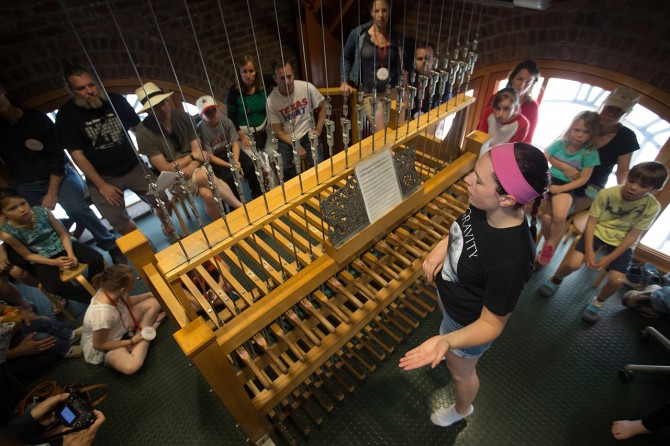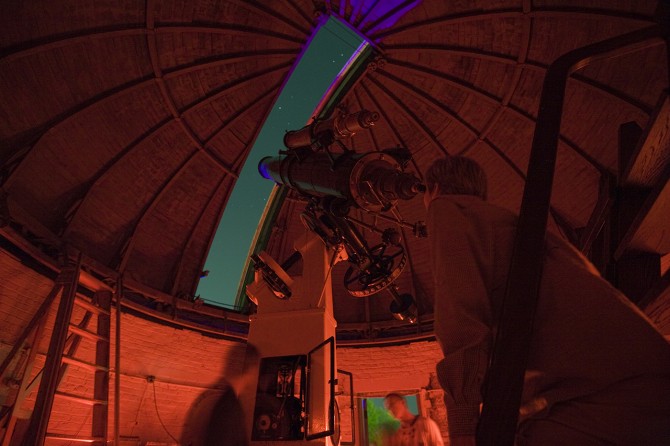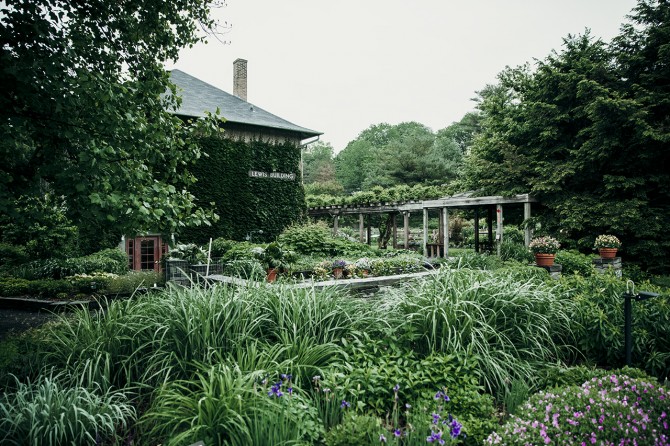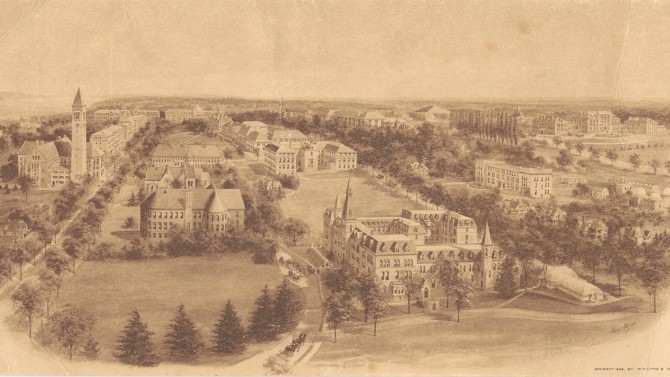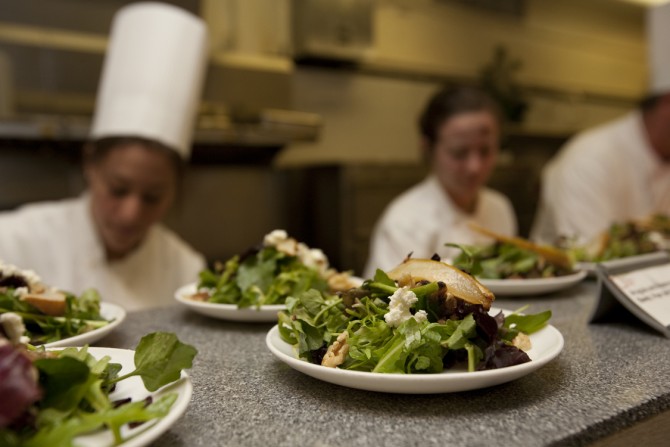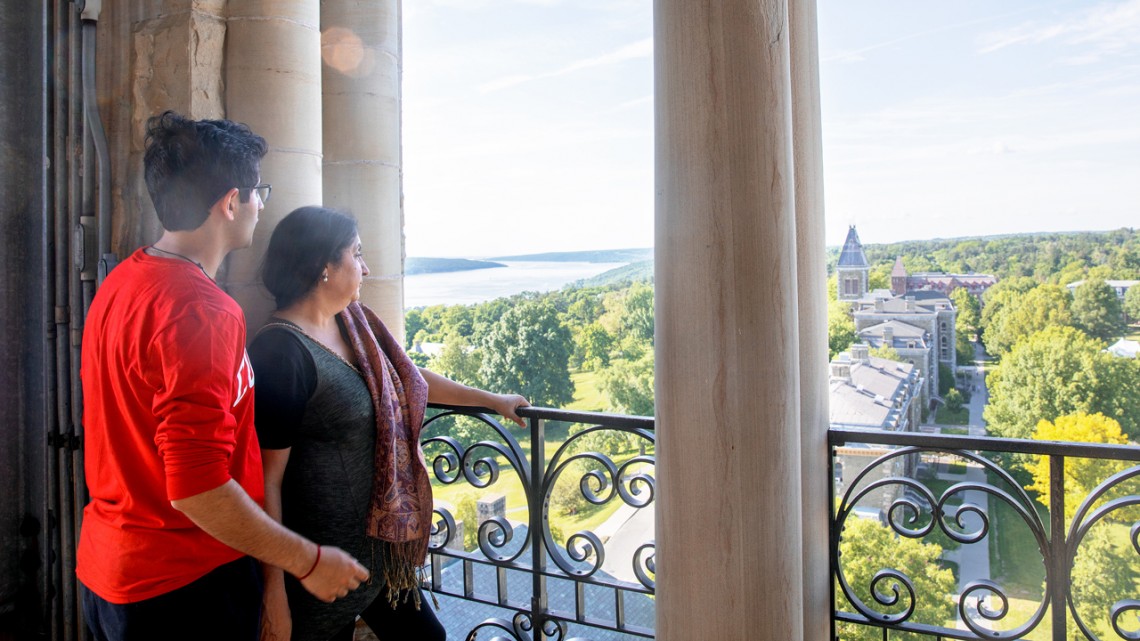
Alumni take in the view at Reunion 2018.
New to campus? Discover Cornell’s rich history
By Blaine Friedlander David Nutt
New Cornell University students, faculty and staff are entering a campus forged by history.
Before Cornell was founded, religious denominations built colleges and adhered to strict, dogmatic curricula. In 1868, Cornell opened its doors and offered a secular education: The new university introduced an innovative, elective-course system, fully embraced diversity and had no ties to a church.
Eventually, nearly every university in the United States adopted Cornell’s approach to curriculum. This led historian Frederick Rudolph to call Cornell “the first American university.”
Go anywhere on this campus, or in Ithaca, and you will encounter living history.
McGraw Tower
If you hear the theme from “The Muppet Show” resonating from the chimes at McGraw Tower, it’s all right. In recent weeks, the chimesmasters also played the Beatles’ “Yesterday,” Yiruma’s “River Flows in You,” Johann Sebastian Bach’s “Gavotte,” and Bon Jovi’s “You Give Love a Bad Name.” However, the most requested song, by far, is “Hedwig’s Theme” from the Harry Potter films. You can climb the 161 steps of the tower and enjoy daily concerts with a bird’s-eye view of campus.
Industrialist John McGraw funded the university handsomely for its early buildings. When he died, he bequeathed his wealth to his daughter, Jennie McGraw, who then became the wealthiest woman in the United States. She gave Cornell the original chimes and the tower that bears her and her father’s name. The chimes were played when Cornell opened its doors on Oct. 7, 1868.
Dairy Bar
The Cornell Dairy Bar in Stocking Hall, the sweetest place on campus, last year sold 7,630 three-gallon tubs of ice cream – about 16.9 scoops per student. Further, the plant sold 21,221 comforting pints of flavors including Mint Chocolate Chip, Cookie Dough Dream, Cornelia’s Dark Secret and Ezra’s Morning Cup.
Today’s food scientists stand on the shoulders of faculty “giants” such as dairy professor Walter W. Fisk, Class of 1906, who in 1917 was asked by the U.S. Department of Agriculture to find more uses for dairy products, and to see if skimmed milk was fit for human consumption.
Observing the heavens
On Fridays from 8 p.m. to midnight during the academic year, the Fuertes Observatory, adjacent to the North Campus residence halls, opens up the heavens to the public. Members of the Cornell Astronomical Society provide rooftop views for your planetary enjoyment; stargazers can also check out the 12-inch Irving Porter Church refracting telescope, built in 1917. Campus observatories once taught engineering students how to operate cutting-edge surveying tools.
The late Cornell astronomy professor Carl Sagan gained fame for his pioneering television program “Cosmos,” on PBS in the late 1970s. He frequently appeared on talk shows to explain the universe. Today, thanks to the Ithaca Sciencenter’s Sagan Planet Walk in downtown Ithaca, you can appreciate the scale of the solar system – from the sun (on The Commons) to Pluto (on Franklin Street, three-quarters of a mile away).
A festive past
While Ithaca is gorges, it’s also festivals. Slope Day on campus started as Spring Day in 1901, founded by Willard Straight, Class of 1901, as a fundraiser for university athletics. Straight also helped to organize the first Dragon Day that same year.
Enjoy Porchfest 2019 on Sunday, Sept. 22, as musicians and bands – mostly acoustic – perform free from the porches and stoops of Ithaca’s Fall Creek and Northside neighborhoods.
Sip hot apple cider and savor kettle corn at downtown Ithaca’s 37th Annual Apple Harvest Festival Sept. 27-29.
Gather your Gryffindor gang for Wizarding Weekend, Oct. 26-27 in Press Bay Alley, featuring magical classes and stories at Tompkins County Public Library and activities on The Commons.
Considering that Cornell offered the first veterinary degrees in the United States, plan for the College of Veterinary Medicine’s popular annual open house in the spring.
Gardens
The shed adjoining the Pounder Vegetable Garden – part of 25 acres of the Cornell Botanic Gardens – is where Nobel Prize-winning plant geneticist Barbara McClintock, M.S. ’25, Ph.D. ’27, worked as a Cornell graduate student nearly 100 years ago. Also enjoy the 150-acre F.R. Newman Arboretum.
At the Botanic Gardens’ Brian C. Nevin Welcome Center, a new exhibit illustrates the impact of the invasive emerald ash borer, which has killed millions of ash trees in North America since the insect arrived in the U.S. in 2002. This exhibit showcases how this invasive pest has upset the intricate relationships ash trees have with the world around them and how the loss of these trees has impacted Haudenosaunee communities. The exhibit was created by Bailee Hopkins-Hensley ’18, MPS ’19, who is passionate about the connections between indigenous communities and the species that sustain them.
If you are walking past the Plant Science Building on Tower Road, don’t miss Minns Garden, with its mix of annual and perennial ornamental plants. The garden is named in honor of Lua A. Minns, the university’s first female floriculture faculty member. And be sure to take a close look at the iron gate on the garden’s south entrance. Can you find the seven famous apples – think Sleeping Beauty and William Tell – hidden on the arch branches?
The telling of telling time
Dashing to an engineering class? Ensure you’re on time by setting your watch to the Joseph N. Pew sundial, designed almost 40 years ago by Dale R. Corson, Cornell's eighth president, and Richard M. Phelan, mechanical and aerospace engineering professor. It is among the most accurate sundials in the world.
In 2011, Bill Nye ’77 – a.k.a. the Science Guy – helped Cornell harvest the sun with the Solar Noon Clock atop Rhodes Hall. When the sun reaches its highest point in the sky daily, a dot under the numeral 12 brightens for a few minutes. Just a note: It’s around 1 p.m. during Daylight Saving Time.
Libraries
Daniel Willard Fiske – who married Jennie McGraw – served as Cornell’s first librarian, from 1868 to 1883. The University Library – now Uris Library, part of the Cornell University Library system – opened Oct. 7, 1891, and the university’s first president, Andrew Dickson White, called it “the noblest structure in the land.” It was designed by William Henry Miller, Class of 1872, who also designed Risley Hall, the old Ithaca High School (now the Dewitt Mall building downtown) and the Cascadilla School on Oak Avenue in Collegetown.
Uris Library features the recently renovated Uris Cocktail Lounge, also known as the Uris Addition.
This space, created in 1982, offers a sweeping view of Libe Slope and has a contemporary look, with cozy furniture and study areas for individual and group work. During the regular semester, the Cocktail Lounge is open 24/7. It’s a beloved late-night study spot.
At the Division of Rare and Manuscript Collections (RMC) in Kroch Library, an exhibit opening Oct. 3 will highlight cartography pieces from the PJ Mode Collection of Persuasive Cartography.
In collaboration with Cornell’s Department of English, Olin Library and RMC will host “Morganfest: A Robert Morgan Celebration,” also Oct. 3, featuring original manuscripts from Robert Morgan, the Kappa Alpha Professor of English, as well as panel discussions, readings and other tributes to the award-winning poet, novelist and historian.
In early November, the Kheel Center for Labor-Management Documentation and Archives of Catherwood Library will present “The Other Side of the Tracks: Discrimination and Social Mobility in Railroad Unions.”
We are where we eat
A.D. White dismissed the idea of dining halls. It wasn’t the university’s obligation, he said. Students ate with Ithaca families, at boarding houses and at Greek houses. But about 100 years ago, alumni began to insist on building dining halls.
Today, Cornell Dining ranks among the nation’s best, thanks to executive chefs like Kevin Moore, who serves fresh vegetables, fruits and other delicious, healthy fare at the Robert Purcell Marketplace Eatery. For example, “Blended Sliders” includes combinations like beef and mushroom, lentil and rice, and turkey and apricot.
Taste history at North Star Dining Room, where the salad bar serves the original historic recipe of the Thousand Island dressing that Cornell trustee George Boldt (original proprietor of the Waldorf Astoria Hotel and namesake of Boldt Hall) adored. Murray Lalonde – great-great grandson of that dressing’s creator, Sophia Lalonde – manages the North Star and brought the original recipe to Cornell.
Savor days gone by at the Atrium Cafe in Sage Hall – formerly the university’s first residence hall for women, built in 1875. Dining in The Ivy Room at Willard Straight Hall? Here’s a little movie Cornelliana: Straight’s daughter, Beatrice Straight, won an Academy Award in 1977 for her role in “Network.”
The art of education
The Herbert F. Johnson Museum of Art, named for Herbert Fisk Johnson Jr., Class of 1922, houses more than 35,000 works. The building was designed by famed architect I.M. Pei, who also designed the East Building of the National Gallery of Art in Washington and the Louvre Pyramid in Paris. On Sept. 7, the Johnson hosts a new museum-wide exhibition, “how the light gets in,” with contemporary art about the movement of people across the globe, and the welcome cracks that develop in our notions of borders.
Other historical campus collections worth finding include the cerebral Wilder Brain Collection, on the second floor in Uris Hall, part of the psychology department. Students may conduct independent research using the Anthropology Collections in McGraw Hall. For people geared toward engineering, it’s poetry in geometric motion at the Reuleaux Collection of Kinematic Mechanisms in Duffield Hall’s Baum Atrium.
Media Contact
Get Cornell news delivered right to your inbox.
Subscribe